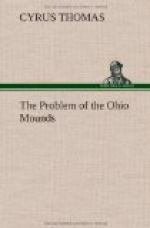Burial beneath or in dwellings.—The evidence brought to light by the investigations of the Bureau of Ethnology, regarding a custom among the mound-builders of Arkansas and Mississippi, of burying in or under their dwellings, has been given, in part, in an article published in the Magazine of American History. [Footnote: February, 1884.] It is a well-attested historical fact that such was also the custom of the southern Indian tribes. Bartram affirms it to have been in vogue among the Muscogulgees or Creeks,[Footnote: Travels, p. 505.] and Barnard Romans says it was also practiced by the Chickasaws.[Footnote: Nat. Hist. Florida, p. 71] C C. Jones says that the Indians of Georgia “often interred beneath the floor of the cabin, and then burnt the hut of the deceased over his head;"[Footnote: Antiq. So. Indians, p. 203.] which furnishes a complete explanation of the fact observed by the Bureau explorers, mentioned in the article before alluded to.
Burial in a sitting or squatting posture.—It was a very common practice among the mound-builders to bury their dead in a sitting or squatting posture. The examples of this kind are too numerous and too well known to require repetition. I may add that the yet unpublished reports of the Bureau show that this custom prevailed to a certain extent in Wisconsin, Iowa, Illinois, North Carolina, Missouri, Ohio, and West Virginia. Instances have also been observed elsewhere. [Footnote: Jones’s Antiq. So. Indians (Georgia and Florida). pp. 183-185.] That the same custom was followed by several of the Indian tribes is attested by the following authorities: Bossu, [Footnote: Travels, vol. 1, p. 251.] Lawson, [Footnote: Hist. Carolina, p. 182.] Bartram, [Footnote: Travels, p. 515.] and Adair.[Footnote: Hist. Am. Indians, p. 182.]
The use of fire in burial ceremonies.—Another observance in which the burial customs of mound-builders corresponded with those of Indians was the use of fire in funeral ceremonies. The evidences of this custom are so common in mounds as to lead to the supposition that the mound-builders were in the habit of offering human sacrifices to their deities. Although charred and even almost wholly consumed human bones are often found, showing that bodies or skeletons were sometimes burned, it does not necessarily follow that they were offered as sacrifices. Moreover, judging from all the data in our possession, the weight of evidence seems to be decidedly against such conclusion.
Among the Indians fire appears to have been connected with the mortuary ceremonies in several ways. One use of it was to burn the flesh and softer portions of the body when removed from the bones. [Footnote: Barnard Romans, Nat. Hist. Florida, p. 90.] Breboeuf also mentions its use in connection with the communal burial of the Hurons. [Footnote: Jesuit Relations for 1636, p. 135.] According to M. B. Kent [Footnote: Yarrow’s Mort. Customs N. A. Indians, 1st Ann. Rept. Bur. Ethnology (1881), P. 95.] it was the ancient custom of the Sacs and Foxes to burn a portion of the food of the burial feast to furnish subsistence for the spirit on its journey.




